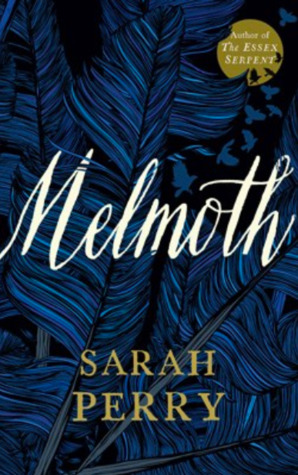
The Blurb (from Goodreads):
For centuries, the mysterious dark-robed figure has roamed the globe, searching for those whose complicity and cowardice have fed into the rapids of history’s darkest waters—and now, in Sarah Perry’s breathtaking follow-up to The Essex Serpent, it is heading in our direction.
It has been years since Helen Franklin left England. In Prague, working as a translator, she has found a home of sorts—or, at least, refuge. That changes when her friend Karel discovers a mysterious letter in the library, a strange confession and a curious warning that speaks of Melmoth the Witness, a dark legend found in obscure fairy tales and antique village lore. As such superstition has it, Melmoth travels through the ages, dooming those she persuades to join her to a damnation of timeless, itinerant solitude. To Helen it all seems the stuff of unenlightened fantasy.
But, unaware, as she wanders the cobblestone streets Helen is being watched. And then Karel disappears. . . .
My Thoughts:
Sarah Perry is a British author who won many fans with her second novel, The Essex Serpent (including me!) An eerie magic realism novel set in Victorian times, The Essex Serpent had a forbidden love story at its heart, along with sightings of a monstrous human-devouring snake. It’s just my kind of book, and so I was eager to read her latest offering.
The title tugged at my memory. I studied Gothic literature at university, and heard about (but did not read) a book called Melmoth the Wanderer, written in 1820 by an Irish Anglican priest Charles Maturin. It’s a classic of Gothic horror, with storm-racked landscapes, midnight scenes set in graveyards, and a creeping sense of claustrophobia and dread. The hero – John Melmoth – attends the deathbed of his uncle, sees an ancient painting of an ancestor, and is mystifyingly told that this ancestor still lives and John shall meet him anon. It turns out that his ancestor sold his soul to the devil in a Faustian pact, but now roams the world trying to foist the deal on to someone else. The book is told as a sequence of stories within stories, in a technique often called a ‘nested narrative’.
I mainly remember the story of Melmoth the Wanderer because Charles Maturin was Oscar Wilde’s uncle and the book was a strong influence on Wilde’s great Gothic masterpiece, The Picture of Dorian Grey. After Wilde was released from gaol, he went into exile on the Continent under the alias of Sebastian Melmoth, the name of the cursed wanderer.
Knowing all this, I expected a dark Gothic tale. I did not realise, however, that Sarah Perry’s novel is actually a kind of retelling of Charles Maturin’s story. The story is inverted, in that both the protagonist and the cursed wanderer in Perry’s tale are women. The frame tale is set in contemporary Prague, rather than 19th century Ireland, but there are many echoes, including the story-within-story-within-story narrative structure.
Helen is a British woman living a life of denial and self-abnegation in Prague. She has few friends, few amusements. One day an acquaintance begs her to read a folder of old documents about a woman named Melmoth. He then disappears. Helen is troubled and unsure. She feels like she is being followed. A clattering of jackdaws in the sombre skies. A woman dressed all in black, seen in the corner of her eye.
Who is Melmoth? you ask.
Let me tell you.
Melmoth once witnessed the resurrection of Christ, but in her fear denied the truth. So she was condemned to wander the earth for ever more, bearing witness to acts of cruelty, betrayal, and atrocity.
She must wander ‘until she’s weary and her feet are bleeding. … she’s lonely, and she wants a companion, so she goes to cells and asylums and burned-out houses and gutters … she’ll follow you down paths and alleys in the dark, or come in the night and sit waiting at the end of your bed … it’s as if she’s been watching all your life – as if she’s seen not only every action, but every thought, every shameful secret, every private cruelty.’
Inevitably Helen begins to read the documents – letters, diaries, and first-hand accounts - and so we go back in time to others who have been haunted by Melmoth. Each one is a masterpiece of ventriloquism: a boy in Nazi-controlled Czechoslovakia who betrays a Jewish friend; a woman about to be burned to death for heresy in the 16th century; a Turkish civil servant who worked for those who masterminded the Armenian massacre. Behind all these tales of grief and horror is the mystery of Helen’s own crime: what did she do to draw Melmoth to her?
This book breaks a great many rules. Helen is an unsympathetic protagonist. Most of the other characters are too. The narrative is fragmented and uneven. The reader is directly addressed again and again:
‘She finds herself unwilling to raise her head to the window, as if she might see beyond the glass a face with an expression of loneliness so imploring as to be cruel. (And since she will not look, you must.)’
The book has divided readers. Some find it slow, boring, repetitive, self-conscious. Others think it is brilliant, provoking, and profound. I’m in the latter camp. It reminds me of other books I have loved – The Historian by Elizabeth Kostova, The Angel of Ruin by Kim Wilkins, The People of the Book by Geraldine Brooks. Each new story takes the reader deeper into the metaphysical truth at the heart of the book. We must bear witness. We must take responsibility. We are all human.
Buy Melmoth NowThe Coffin Path is a similar genre that you also might enjoy:

